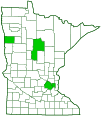false black widow
(Steatoda grossa)
Conservation • Description • Habitat • Biology • Distribution • Taxonomy
Conservation Status |
|
|||||||
| IUCN Red List | not listed |
|||||||
| NatureServe | not listed |
|||||||
| Minnesota | not listed |
|||||||
Description |
||
False black widow is an exotic (non-native), small, cobweb weaver. It is native to Europe but has been widely distributed through human activity. It now occurs in Asia, Australia, New Zealand, and North and South America. In the United States very common on the West Coast and common in the southeast. It is uncommon in Minnesota. It is found mostly in and around houses and buildings. It is rarely found outdoors. False black widow looks similar to the black widow but is slightly smaller. Females are ¼″ to ⅜″ (6 to 10 mm) long, males are 3 ⁄16″ to ¼″ (5.6 to 7.0 mm) long. The front part of the body (cephalothorax) of the female is glossy and flat. The hardened plate (carapace) covering the cephalothorax is yellowish-brown. There are four pairs of eyes arranged in what appears to be two more or less parallel rows. The first row of four eyes, consisting of the anterior median eyes (AME) and anterior lateral eyes (ALE), is curved backward. The second row, consisting of the posterior median eyes (PME) and posterior lateral eyes (PLE), is straight. The AME are small and dark. All of the other eyes are pale. On each side the ALE and PLE are very close together, less far apart than the radius of an eye. The back part of the body (abdomen) is glossy, oval to spherical, and rounded in the back. The upper side of the abdomen purplish-brown to blackish-brown with pale markings, including a band around the front, a longitudinal row of three spots in the middle (middorsal), and one spot on each side. The spots are discrete, not connected. Sometimes the markings are barely discernible. The legs are slender and medium-long. The front pair is slightly longer than the rear pair. On the last segment (tarsus) of each hind leg there is a row of 6 to 10 serrated, slightly curved bristles. This feature gives the family Theridiidae one of its common names, “brush-footed spiders”. |
||
Size |
||
Female Body Length: ¼″ to ⅜″ (6 to 10 mm) Male Body Length: 3 ⁄16″ to ¼″ (5.6 to 7.0 mm) |
||
Web |
||
|
||
Similar Species |
||
Habitat |
||
Buildings, caves |
||
Biology |
||
Season |
||
Year round |
||
Behavior |
||
The spider hangs upside down in the web. |
||
Life Cycle |
||
|
||
Food |
||
Mostly pill bugs and black widow spiders, but also any insects and arachnids that are snared in the web. |
||
Distribution |
||||
|
Sources 24, 29, 30. |
|||
| 8/3/2020 | ||||
Occurrence |
||||
Uncommon in Minnesota |
||||
Taxonomy |
|||
| Class | Arachnida (Arachnids) | ||
Order |
Araneae (Spiders) | ||
Suborder |
Araneomorphae (Typical Spiders) | ||
| Infraorder | Entelegynae | ||
| Superfamily | Araneoidea (orbweavers and allies) | ||
Family |
Theridiidae (cobweb spiders) | ||
Genus |
Steatoda (false widow spiders) | ||
Subordinate Taxa |
|||
false black widow (Steatoda grossa grossa) false black widow (Steatoda grossa obliterata) false black widow (Steatoda grossa strandi) |
|||
Synonyms |
|||
Teutana grossa |
|||
Common Names |
|||
false black widow |
|||
Glossary
Carapace
The hard, upper (dorsal), shell-like covering (exoskeleton) of the body or at least the thorax of many arthropods and of turtles and tortoises. On crustaceans, it covers the cephalothorax. On spiders, the top of the cephalothorax made from a series of fused sclerites.
Cephalothorax
The front part of a spider’s body, composed of the head region and the thoracic area fused together. Eyes, legs, and antennae are attached to this part.
Tarsus
On insects, the last two to five subdivisions of the leg, attached to the tibia; the foot. On spiders, the last segment of the leg. Plural: tarsi.
Visitor Photos |
|||||
Share your photo of this arachnid. |
|||||
| This button not working for you? Simply email us at info@MinnesotaSeasons.com. Attach one or more photos and, if you like, a caption. |
|||||
Shylo Morgan |
|||||
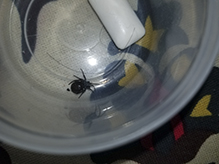 |
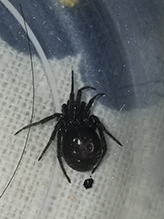 |
||||
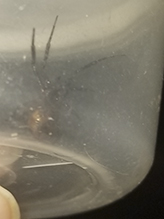 |
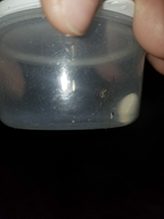 |
||||
Luciearl |
|||||
Found this in my sink. If you look closely you'll see the water droplets. |
|||||
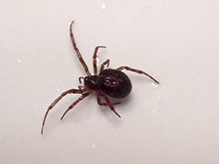 |
|||||
MinnesotaSeasons.com Photos |
|||||
|
|||||

Slideshows |
||

Visitor Videos |
|||
Share your video of this insect. |
|||
| This button not working for you? Simply email us at info@MinnesotaSeasons.com. Attach a video, a YouTube link, or a cloud storage link. |
|||
Other Videos |
|||
| FALSE WIDOW HANDLING AND FEEDING! [] Spider Bed and Breakfast 4 Arachnobros UT |
|||
About
Jun 21, 2017 Watch us feed and handle a Steatoda Grossa (False Widow) in the latest episode of Spider Bed and Breakfast! Thank you so much for watching! |
|||
| False Black Widow / Cupboard Spider - Steatoda grossa Mostly Nature |
|||
About
Jan 13, 2017 Cupboard spider or False black widow - Steatoda grossa Variously known as the Cupboard spider, the Dark comb-footed spider, the Brown house spider and the False black widow. It is related to the infamous Red-backed spider and the Black widow spider. I caught this one running across my kitchen bench. After a short photo shoot I released it in the garden. The body colour and pattern can be quite variable from whitish yellow to brown with pattern, to almost black with blurred pattern. Is it dangerous? According to Wikipedia, "The bite of S. grossa is known to be medically significant in humans, but minor, without any long-lasting effects. Symptoms of bites include blistering at the site of the bite, muscle spasms, pain, fever, sweating, and/or a general malaise lasting for several days. Latrodectus antivenom was shown to be effective in treating bites from Steatoda grossa after it was mistakenly administered to a S. grossa bite victim who was erroneously believed to have been bitten by the far more dangerous Redback". |
|||

Visitor Sightings |
|||||
Report a sighting of this insect. |
|||||
| This button not working for you? Simply email us at info@MinnesotaSeasons.com. Be sure to include a location. |
|||||
| A Grace 9/8/2025 |
Location: Eagan, MN outside on house |
||||
| Lila 9/8/2025 |
Location: Isanti, MN found on grill covering protected open porch |
||||
| Shylo Morgan 8/1/2020 |
Location: Ada, MN |
||||
| Luciearl 10/24/2019 |
Location: Cass County Found this in my sink. If you look closely you'll see the water droplets. |
||||
MinnesotaSeasons.com Sightings |
|||||
|
|||||

Created: 11/19/2019
Last Updated:
